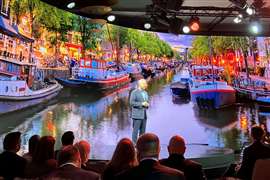Geotechnical work starts on SR 520 bridge
29 July 2010
A team of surveyors from Washington State Department of Transport (WSDOT) has begun fieldwork in Lake Washington to study the lakebed where support columns and anchors will be placed for a new SR 520 bridge.
The team plans to use barge-mounted drill rigs alongside the floating bridge between Medina and the west end of the floating bridge. Nearly 40 borings will be completed, with a depth of 60 to 100 ft (18.2 to 30.5 m) into the lakebed.
The results of the fieldwork will be shared with potential design-build teams as WSDOT moves closer to construction. Smaller efforts were conducted previously on the preliminary anchor design. This more robust geotechnical work allows WSDOT to advance the design of the anchors prior to issuing the contract documents for the floating bridge.
"Learning the strength and composition of the underwater soils is a key step to properly designing the columns and anchors for the new bridge," said SR 520 program director Julie Meredith.
WSDOT is also completing an environmental review of the I-5 to Medina Bridge Replacement and HOV Project, which proposes to replace the floating bridge with a six-lane facility and reconstruct the Seattle interchange.
Construction on a new floating bridge is scheduled to begin in 2012, and a new floating bridge is scheduled to open to traffic in 2014.
For more information about the SR 520 Bridge Replacement and HOV Program and the fieldwork, please visit www.wsdot.wa.gov/Projects/SR520bridge/
Project overview
The SR 520 Bridge Replacement and HOV Program will enhance safety by replacing the aging floating bridge and keep the region moving with vital transit and roadway improvements throughout the corridor.
The 12.8-mile program area begins at I-5 in Seattle and extends to SR 202 in Redmond.
There are four projects in the SR 520 Bridge Replacement and HOV Program:
- I-5 to Medina: Bridge Replacement and HOV Project
- Medina to SR 202: Eastside Transit and HOV Project
- Pontoon Construction Project
- Lake Washington Congestion Management Project
SR 520 is one of two east-west roadways across Lake Washington. About 115000 vehicles carrying 190000 people travel the SR 520 Evergreen Point Bridge every day.
Built in the 1960s without the benefit of today's design standards, the Evergreen Point Bridge and the Portage Bay Bridge are vulnerable to windstorms and earthquakes and are at risk of collapse if they are not replaced.
A collapse of these bridges or their approach structures could cause serious injury or loss of life, and would overwhelm all major regional highways with re-routed traffic.
The End Result
WSDOT crews will replace the existing bridge with a new, safer bridge designed to withstand earthquakes and windstorms and the entire corridor with two general-purpose lanes and one HOV lane in each direction.
Project Benefits
The new SR 520 corridor will move more people across Lake Washington to and from work, school, home, and recreation.
Reliability and mobility will be improved with:
- Two general-purpose lanes and one continuous HOV lane in each direction.
- Rebuilt overpasses and on- and off-ramps throughout the program area will improve traffic flow.
- New, wider shoulders, allowing disabled vehicles a place to pull out of traffic.
- More commuting options with a bicycle/pedestrian path.
Project timeline?
2010 - Complete innovative pontoon construction testing effort.
2010 - Activate Smarter Highways traffic management features.
2010 - Begin new pontoon site construction in Grays Harbor.
2011 - Begin construction of the Eastside Transit and HOV Project.
2011 - Begin tolling the existing bridge.
2012 - Begin construction of new floating bridge.
2014 - Open new floating bridge to drivers.
The schedule for constructing the other segments of the corridor is pending additional funding.
STAY CONNECTED


Receive the information you need when you need it through our world-leading magazines, newsletters and daily briefings.
CONNECT WITH THE TEAM










